Here in the US, the time is drawing near for the release of Yvette Stanton’s newest needlework book, Hardanger Filling Stitches! Yay!
This is a book I’ve been anticipating ever since I heard she was writing it! So I’m pretty excited it’s almost here, and I’m even more excited to be able to offer it to you through my shop, where you can pre-order it now for shipment in the first week of March.
Hardanger Filling Stitches is everything you could want in an instructional book on Hardanger fillings, from traditional to contemporary. If you are a Reticello enthusiast, you will immediately recognize that the filling techniques covered in the book can apply equally well to Reticello and other forms of gridded cutwork that produce a lace-like effect.
Let’s take a look at the book up close…

Hardanger Filling Stitches is a step-by-step handbook to over 100 filling stitches and variations for Hardanger embroidery, which can also be used in other forms of gridded cutwork as well (like Reticello and similar styles).
In true Yvette form, the book leaves nothing wanting. With her excellent approach to instruction through precise diagrams, clear photos, and concise text, Yvette leads the learner along a well-defined path towards confidant mastery of the techniques.
Everything in the book is engineered for complete learning, so that the reader can achieve success without facing unanswered questions or gaps in the learning process.
It is a thoroughly thorough book.
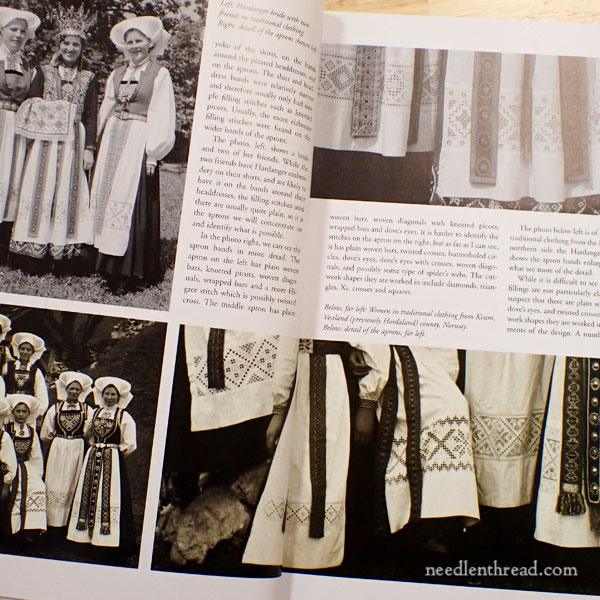
The book begins with a history of Hardanger, covering the development of Hardanger needlework up to contemporary times.
I like that Yvette does this with her whitework books. She puts the whitework into its cultural context, which is important for the study of any regionally-specific art.
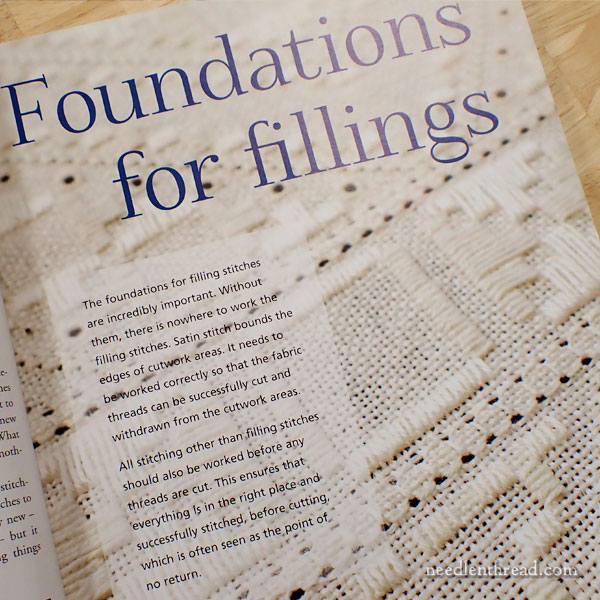
As far as the instruction goes, we begin with the foundations of Hardanger.

In this section, we learn all about fabrics and threads and then we learn how to create the “ground” into which all the filling stitches can be worked.
We also learn the basics – like how to read a chart, how to start and end threads invisibly, how to work satin stitch blocks in various directions, how to cut away the fabric for the open spaces, and so forth.
Throughout the instruction in basics, you’ll find plenty of tips and troubleshooting, so that you can gain confidence as you move towards the more complex forms of Hardanger fillings.
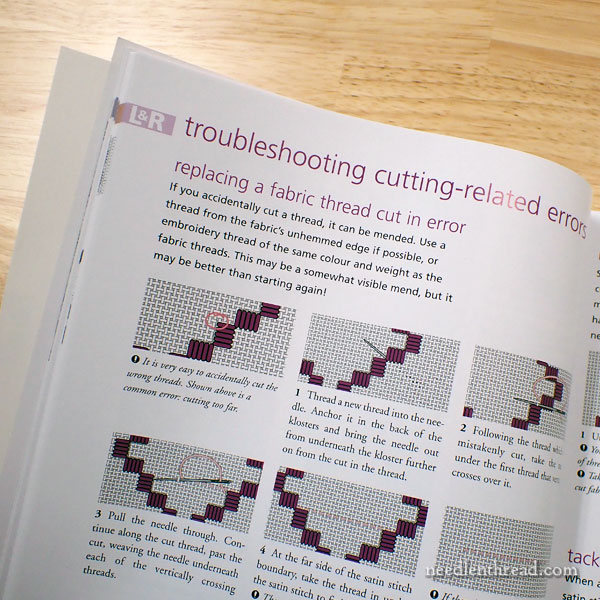
Troubleshooting is such an important part of learning any skill!
I really appreciate the fact that Yvette focuses on particular areas of troubleshooting in Hardanger. After all, if you can’t find your way over an obstacle, sometimes it’s pretty easy just to give up.
Like a good teacher, she doesn’t want you to do that. She takes you through troubleshooting processes, and by doing so, helps you figure out how to troubleshoot for yourself. And that type of knowledge – and the confidence that comes with it – will benefit the learner in other needlework situations as well.
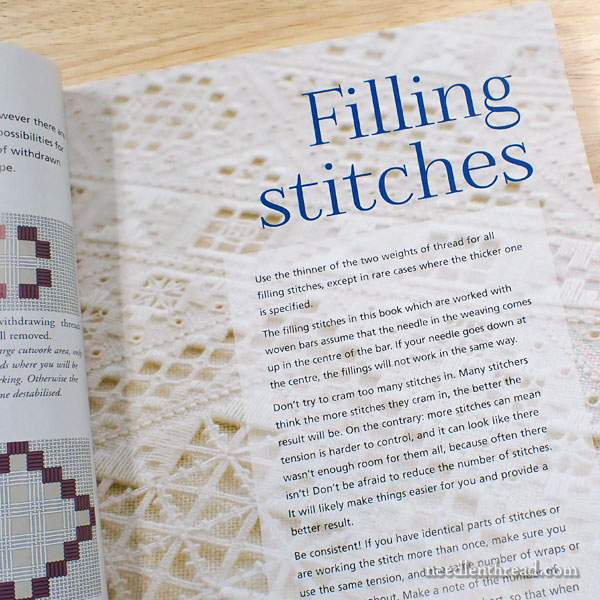
After the foundations, we hit the bulk of the book, which is the filling stitches.
As mentioned before, there are over 100 filling stitches and their variations in the book. And they’re all beautiful! The fillings are the crucial elements that bring out the lace-like aspects of Hardanger.

For most of them – and for most of the diagrams in the book – you’ll find left-handed and right-handed instructions.

One really neat thing that Yvette does throughout the book – I think it’s very clever and useful – is aligning photos of the finished embroidery with the grids from which the embroidery is worked. What a helpful visual approach!

All those filling stitches are accompanied by thorough diagrams. Throughout the diagrams, you’ll find more photos of finished examples.
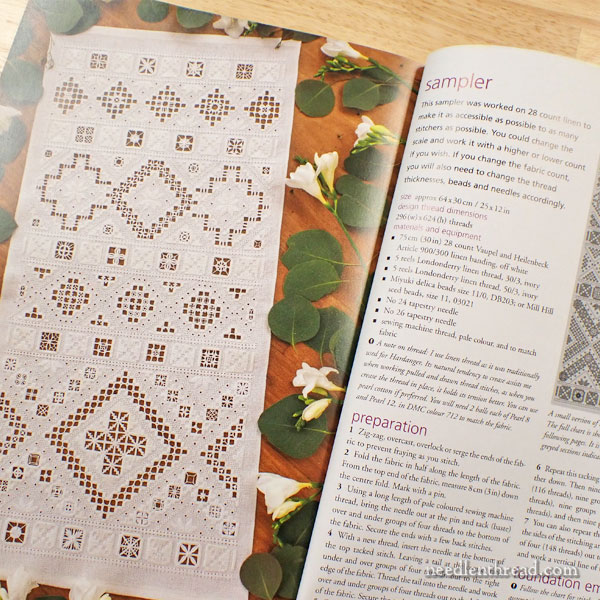
Finally, towards the end of the book, there is a fabulous sampler to work, in which you can incorporate all your new-found knowledge and skill.
The sampler is presented as a chart. The charts are accompanied by a materials list and all the relevant information for you to re-create the sampler.

It’s a stunner!
The book is 280 pages, so it’s no small volume, and there’s a lot packed into those pages!
In a nutshell, what can I say? Hardanger Filling Stitches, suitable for beginners and beyond, is essential for your needlework library if you have any interest at all in the various forms and techniques of gridded whitework like Hardanger.
It’s superb in every way!
Of course, if you’re familiar with Yvette Stanton’s whitework and other embroidery books, you really couldn’t expect anything less.
Available for Pre-Order
Hardanger Filling Stitches is available for pre-order in my shop here at Needle ‘n Thread.
It will be shipped via Priority mail, tracked and insured, in the first week of March, when it becomes available for the US market.
If you’re not in the US, you can find the book through Yvette’s website here.







I heartily agree with your review. Here in the UK, my copy arrived last weekend — very lucky!
One other aspect of the book that I think is useful is that the author labels the filling stitches as “contemporary” and “traditional”. This is handy for two reasons. One, if you only want to stitch in a traditional manner, you don’t have to guess which fillings to use. And two, it is fascinating to see how Hardanger as a technique has developed over the years, incorporating new and interesting filling stitches.
The sampler looks great fun!
Thank you, Mary, for your comprehensive review, and your very kind words. I’m very grateful. Just one small correction: the book is 280 pages, not 168. So it’s even bigger than you thought!
Well Mary, you’ve done it again. You review a book and my bookcase cries “not more.” My copy arrives on Saturday, weekend taken care of. Keep up the wonderful work you do, even if it does mean a hit on my purse.
OMG! I just started my first hardanger project a few days ago. I searched the site for some stitches but couldn’t find them.
Great minds huh?
Love your site!!
This book sounds like a dream come true. Okay, I don’t dream hardanger but I have several cross stitch designs that incorporate hardanger and I’m terrified to try them. Cross stitch to me is the Ultimate Slow Stitching. I think plain old hand embroidery is quicker. If I buy this, maybe I’ll pick up those patterns and try them. The center part looks like a small cross stitch so it’s not like I’ll be wasting a lot of time stitching it but regardless I hate to try cut work and mess it up. This almost looks like she’s holding your hand as you work it. The troubleshooting part, I spied what to do if you accidentally cut the wrong thread, another what the heck would I do moments. Definitely checking my budget next month to see if I can swing it after next payday.
I have two other books by Yvette and love them. I’m especially appreciative of the fact that she include left-handed directions. Ordinarily I can adapt, but when doing a connected circle of kloster blocks, just working in the opposite direction doesn’t seem to work out. I’m hoping this book will help me figure out how to finish a class project from several years back.
Her diagrams and photos are outstanding, and her instructions are easy to follow. I’m very much looking forward to my copy!
I love how Yvette does her research and makes these wonderful books!
As a Norwegian it’s lovely to see our cultural heritage brought into the wide world. I have one previous one on smøyg, also very pretty!
My mother actually comes from Hardanger, so I can wear a bunad(national costume) from this area. The blouse has hardanger around the buffs, neck band, and on the apron, very pretty.
There’s also a lot of both wool embroidery on the costume, and other white work depending on which area you come from, so the craft is alive and well as almost everyone owns a bunad here. I encourage you to look at all the variations of bunads, some are very beautiful indeed. I’m embroidering one at the moment.
Don’t be intimidated to try hardanger, it’s not that complicated, but the results can be stunning! I inherited two large tablecloths from my grandmother, on in English white work(cut work), and a magnificent huge hardanger one, that comes out for Christmas and on our national day(17th of May)- it’s one of my most treasured possessions.
My plan is to make a white on white hardanger tablecloth, but include some mirror work on it- sort of like a starry sky and wintery fields. Not sure how it will wash though, so must make some tests.
Now I’ll go and order that book…